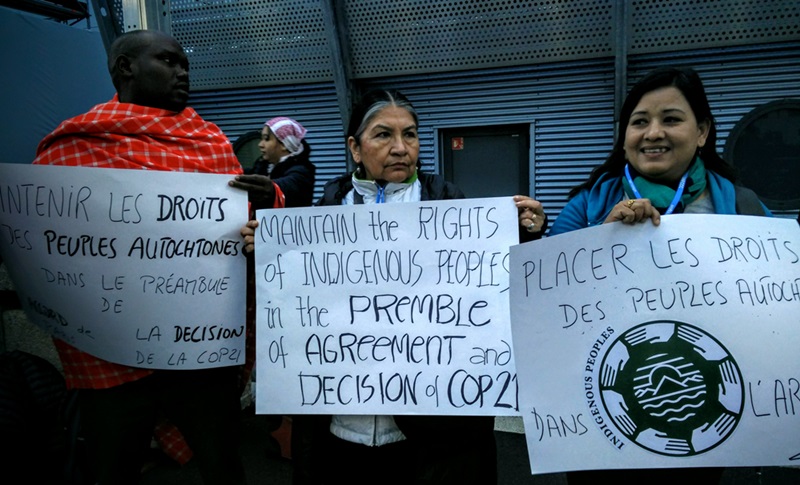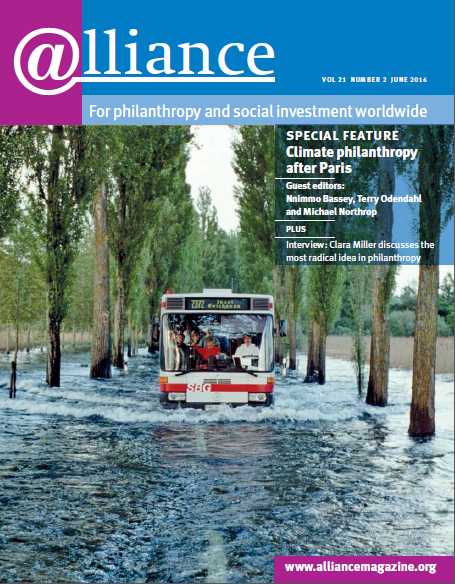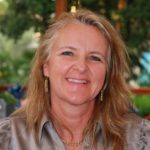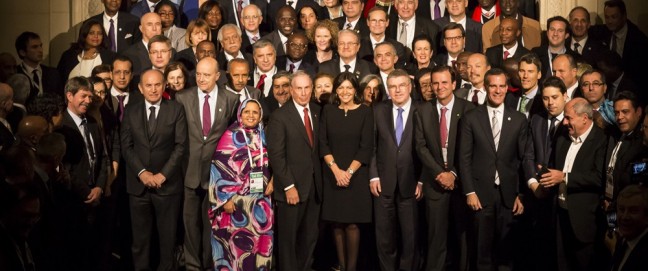Within the field of climate change, the issue of climate justice has been neglected. The Oak Foundation, however, believes that issues of climate justice are central to the whole climate change question and is poised to launch a new climate justice initiative. Florence Tercier and Anne Henshaw of the Oak Foundation talk to Charles Keidan about the thinking behind the new fund, and their hopes for more resources to be focused on climate justice and more attention given to local communities at the sharp end of climate change.
How big is Oak Foundation in terms of the level of spending and endowment?
Florence: It doesn’t have an endowment but the grantmaking budget is slightly over $200 million per year shared between all programmes. The resources of Oak Foundation originated from an interest in the Duty Free Shoppers business that Alan Parker helped to build. The foundation is family-led and professionally staffed. The board consists of six trustees drawn from the three generations of the family. We work internationally in very diverse programme areas addressing a range of social and environmental issues. There are seven programmes and the new climate justice initiative combines the forces of several of them.
Can you tell me about the evolution of the climate justice initiative?
Anne: In 2014, Oak made a large multi-year grant to the ClimateWorks Foundation to focus on climate mitigation.
The trustees also wanted to ensure that the human dimension and the social justice issues the foundation cares about weren’t lost in the work. So Kathleen Cravero, president of the Oak Foundation, created a cross-programme steering committee made up of the directors of our programmes in international human rights, housing and homelessness, child abuse, issues affecting women, and the environment programme. We have spent the last two years developing a vision for how we define climate justice and a related grantmaking strategy drawing from a range of experts in the field. Based on that process, we built the strategy around two key pillars of work.
‘We see adaptation and mitigation as intertwined, so we wanted to make investments that recognized that connection. We saw the Paris Agreement as a real opportunity to advance the agenda.’
Essentially, we see adaptation and mitigation as intertwined, so we wanted to make investments that recognized that connection. We saw the Paris Agreement as a real opportunity to advance the agenda, so one of our pillars was to amplify the voices of some of Oak’s core constituencies including youth, women and indigenous people. We recognized that they are not only affected by climate change, but also the ones that can come up with solutions that will meet the needs of their communities. So we made an initial round of grants in 2015 to that end. That’s the first pillar.
We then spent the second year developing a strategic framework that would direct grantmaking to communities on the ground to help them build their resilience to climate change in the Arctic, East Africa and the Bay of Bengal. The strategy has four main strands – food security and food sovereignty, water access, migration and relocation, and sustainable livelihoods. Again, the focus is on helping youth, women and indigenous people build a movement that will amplify their voices and help to develop their resilience to climate change.
How did you decide to focus on Bengal, East Africa and the Arctic?
Anne: The trustees didn’t want to expand beyond the existing footprint of our current grantmaking and we wanted to choose areas where the impacts of climate change were really clear.
And how will this work?
Florence: The first two years were really to build the strategy and to do the first round of grantmaking to support groups to make their presence felt in Paris. Now that the strategy has been approved by the trustees, Anne is in the process of creating a resilience fund that is outside Oak.
Oak has numerous partners in its climate change work. Do you see this new entity as independent but working alongside your existing partners, or could it find itself within one of those partners?
Florence: The new fund will be working with Oak and existing partners but the ambition is also to find new partners to pool funds and to have more impact, particularly funders that have strategies that align with Oak Foundation’s strategy.
‘We want to work with other foundations to build the field overall.’
Anne: A lot of climate funding is purely focused on mitigation and I think Oak sees a real opportunity to build the social justice element of climate philanthropy. We want to work with other foundations to build the field overall, and hopefully leverage some of these new funds around adaptation. I’d also like to add that the way we’ve structured the strategy recognizes the intersection between different fields. We think that this is where philanthropy is going, and we need to work across sectors. The elements of justice – whether you’re talking about women’s rights, human rights or indigenous rights – are all connected, and we think that through the lens of climate justice, we can bring some of these things together to really advance the rights of people across the board.
Florence: In addition to building on our thematic and geographic experience, we also want to build on our approach to philanthropy. Oak programmes stress movement building and how you actually go from the grassroots and build the capacities, connect groups and equip them with leadership capacities, and we’ll be applying this approach to the climate justice initiative. So we will be looking at how groups have been working to advance and claim their rights and how that experience can be combined with the adaptation models that they are trying to implement. We plan to launch the initiative later in 2016.
I see it’s a three to five year programme. How much of Oak’s funding will be allocated to it?
Florence: The level of funding and investments for this particular initiative is USD $25 million over five years.
And that will be alongside the existing environment work on conservation?
Anne: Yes. The environment programme as a whole is about $38 million a year. The work in the Arctic is very aligned with climate justice strategy already, so that will be largely on top of the $25 million investment. There are certain elements like migration and relocation that don’t fall within the current climate resilience strategy in the Arctic, but, hopefully, these will be covered through climate justice. And as we mentioned earlier, the initial investment is really intended to grow the pot. Whenever Oak works in an area, we like to work with partners and collaborate, and we see a real opportunity to leverage that money considerably over the five-year period.
‘Whenever Oak works in an area, we like to work with partners and collaborate.’
Do you have any targets for that leverage?
Anne: We think that, for example, there are opportunities to work alongside some of the accredited organizations that are putting in proposals to the Green Climate Fund, but what we want to do is make sure that those kinds of funds actually reach the communities most affected. As the Green Climate Fund develops, it’ll be important to build transparency and accountability in how those funds are being used, and we think there’s an opportunity to work with regional partners in some of these geographies to ensure that happens.
I understand that only about 2 per cent of foundation grants and spending goes to addressing climate change. Does that suggest that your philanthropic peers are not giving enough attention to the issue?
Florence: In the process of defining our strategy, one of the things we did was to map the funding that goes towards global adaptation and resilience because funders come at this from different angles. What was clear was that a whole set of funders are not calling what they do climate justice or adaptation.
‘We can help the communities come forward and demonstrate to the policy community that this is a solution that they have helped build. We see this as a specific role for philanthropy because of its flexibility.’
But that’s the area they may actually be working in?
Florence: Exactly. If we can pilot grassroots initiatives to develop local solutions and to give the ownership of developing those solutions to the local communities, we can help the communities come forward and demonstrate to the policy community that this is a solution that they have helped build. We see this as a specific role for philanthropy because of its flexibility. This will then undam the larger stream of funding from bilaterals and multilaterals, particularly on the issue of adaptation and resilience, and this is one of the ultimate aims of the initiative.
The focus of this issue of Alliance is the Paris Agreement. What do you think was gained and what was missed at Paris?
Anne: First, we recognize that this is a landmark agreement. The fact that 195 nations came together to sign something that stems greenhouse gas emissions and tries to keep temperature rises below 2 °C is enormous.
On the other hand, several of our partners felt like the agreement didn’t go far enough with respect to human rights. Because human rights language is not included in the operative text, it will really be hard to hold states accountable for the impact that is being felt by local communities. That being said, both Florence and I were struck that the discourse around climate justice was everywhere and I think it made a difference in the terms of the final agreement. Looking forward, we’re going to have to think about how we can build on some of the language that was included. We want to work with some of our partners that were in Paris – the Women’s Environmental and Development Organization (WEDO); Tebtebba, a global indigenous organization to help build the voice of indigenous people; the Global Greengrants Fund; and 350.org, which helped in building up the voice of youth in Paris, along with the Earth Journalism Network which brought journalists from over 40 countries, largely from the developing world, to the meeting – to see how we can strengthen what is in the agreement.‘Several of our partners felt like the agreement didn’t go far enough with respect to human rights.’

One of Oak’s partners is Tebtebba, a global indigenous organization to help build the voice of indigenous people.
Florence: The issue of gender was much more prominent in Paris, thanks to the work of some of our grantees and a lot of women’s organizations that have been really pushing for that. I think the real challenge is the implementation. If women continue to be marginalized, it’s going to make it difficult for them to be part of the process. So building social justice, advancing rights at the same time as we are looking at adaptation and resilience models, is crucial.
‘Building social justice, advancing rights at the same time as we are looking at adaptation and resilience models, is crucial.’
Oak Foundation’s thinking on the climate justice initiative preceded the Paris Agreement. To what extent will the agreement inform your thinking about what to do next?
Anne: Paris was definitely an important moment for us because it really catalysed the steering committee to recommend a series of grants in 2015, before we had a full-blown strategy worked out. But we recognized that there’s a lot of work that needs to be done post Paris, and the nice thing about working at Oak is that it recognizes the value of multi-year grants and supporting organizations over a longer time frame.
Florence: At the beginning of the discussions on the initiative, we had a meeting with people from the climate change movement and it was really contentious. We had people telling us that climate justice is a very controversial issue and it applies to different things. Now, after Paris, I think people see that it’s actually one of the central issues, and that the whole notion of justice needs to be integrated in the implementation of any agreement.
What about the leadership role of Oak in all this? Are there plans to show visible strong public leadership to persuade philanthropic peers to become more involved?
Anne: Oak operates largely on the model that we ‘lead from behind’. We really work through our partners and we value the work they do. It’s not about us, it’s about who we serve.
Florence: It’s also about supporting the partners that are taking the risks. People involved in those groups are taking real risks and those risks are increasing all the time.
Anne Henshaw is programme officer – marine conservation, Arctic and North Pacific.
Florence Tercier heads the Issues Affecting Women programme of Oak Foundation.










Comments (0)